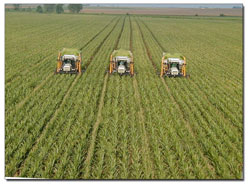|
| ||
| The business of hunger
by Ari LeVaux
On March 8, Olivier De Schutter, the United Nations Special Rapporteur on the right to food, released a report arguing that the use of small-scale, diverse farming methods, which he calls “agroecology,” can double agricultural production in poverty-stricken areas, increase the economic prospects of the inhabitants and improve their local environment. This argument refutes a common dismissal of sustainable agriculture: that it could never feed the world. That’s the contention of those who believe in agriculture methods that involve the intensive use of energy, water, machinery and chemicals to grow cash crop monocultures. I recently discussed these competing paradigms with De Schutter, in the context of what it might look like if industrial agriculture were, in fact, to feed the world. “I’m surprised at the simplistic diagnosis that appears to be dominant in public discourse,” De Schutter said. “The official mantra is we need a 70 percent increase in agricultural production to feed the world. But this completely oversimplifies the debate. It only pays attention at the supply side of the equation, when we must also work on demand – for instance the overconsumption of meat in industrialized countries. By 2050, if the current curves continue, 50 percent of global cereal production will go either to feeding cattle or to the irresponsible push toward biofuels production and consumption through fiscal stimuli and subsidies.” Corn and soy, two of the world’s most common crops, are both typically grown with industrial farming methods. Growing corn and soy for cattle feed is a terribly inefficient way to produce food calories, and using corn to produce ethanol is an inefficient way to produce fuel. Clearly, the easiest way to increase the food supply is to grow food for people, not cows and cars. Another problem with a myopic focus on the supply-side, according to De Schutter, is “...it neglects the urgent need to combat waste. We lose 30 to 35 percent of crops post-harvest because of poor storage facilities and communication infrastructures in developing countries.” Despite the many holes in the supply-side solution to world hunger, for the sake of argument let’s suppose industrial agriculture becomes the path that humanity chooses, and consider how that might look. If recent history is any guide, it may play out with farmers in wealthy countries producing surpluses that are shipped to poor countries. These surpluses are only possible with agriculture subsidies and cheap oil, neither one of which are reliable in the long-term. Elsewhere in the world we can find examples of another possible future scenario, in which industrial agriculture methods are exported to the third world. This happened 40 years ago in Punjab, India, which in the 1970s became a poster child for industrial agriculture. Huge gains were recorded, especially in wheat production. But according to a 2007 report put out by the Punjab State Council for Science & Technology, “Over intensification of agriculture over the years has led to water depletion, reduced soil fertility and micronutrient deficiency, nonjudicious use of farm chemicals & problems of pesticide residue, reduced genetic diversity, soil erosion, atmospheric and water pollution, and overall degradation of the rather fragile agro ecosystem of the state.” Here at home, the experience of American farmers demonstrates the effectiveness with which industrial agriculture can destroy the social and economic fabric of rural communities. Across the heartland, a few farms have prospered and consolidated the land from the many farms that have failed. Once autonomous, farmers became workers on factory farms or left home for the city. In the third world this pattern would likely be repeated. Small farmers would become day laborers, or move to the already swollen urban slums. Third world farmers that hang onto their small pieces of land could face the constant threat of financial ruin if they follow the path of industrial farming. India is experiencing an epidemic of farmer suicides resulting from farmers borrowing money for pesticides, fertilizers, high-yield seeds and the digging of wells. If a crop fails, or spoils, or the price of that crop takes a sudden dive, or the well runs dry – any of these all-too-common occurrences can initiate a dept spiral that many farmers can’t find their way out of. Since 1997, more than 200,000 Indian farmers have committed suicide. Many proponents of hi-tech farming methods like to claim theirs is the scientific approach, a notion that makes De Schutter bristle. “Agroecology is science – it’s the combination of agronomics and ecological science, and it’s the kind of science that is best suited to the needs of the 21st century, where resource efficiency should be the prime objective. The priority should be to save water, preserve the soils, and de-link agriculture from fossil energies. “Agroecology is not a return to some traditional past, it is the cutting edge of farming. It mimics nature in the field, and uses resource-saving techniques that can be of greatest benefit to cash-strapped farmers and to women, for whom access to credit is most difficult, and who cannot afford to run high levels of debt.” Given an infinite amount of oil, water and aid money, it’s probably true that industrial agriculture could feed our growing population. But it’s difficult to imagine how that might look good. De Schutter’s report gives scientific support to the idea that farming in a way that strengthens communities and local economies, spares resources and models diverse ecosystems can also feed the world. Unless you own stock in oil, chemical or agribusiness companies, it’s hard to see how agroecology methods don’t make a lot more sense. •
|



 The world’s population will probably hit 9 billion by 2050. That’s about the only thing agreed upon by partisans in a long-waged debate over how best to feed all those bellies.
The world’s population will probably hit 9 billion by 2050. That’s about the only thing agreed upon by partisans in a long-waged debate over how best to feed all those bellies.